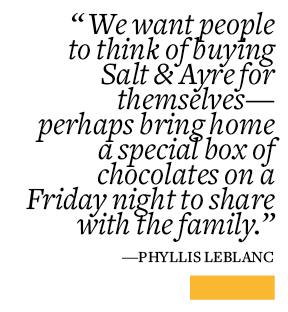Griselda Encarnacion, operations manager at Harbor Sweets, gets to perform an enviable task; along with operations co-manager Carol Haefner, she is experimenting with Harbor Sweets’ new chocolate-enrobing machine. The two women place small, perfect squares of almond butter crunch on a conveyor belt that carries them through a stream of melted, 70 percent dark chocolate. The candy pieces then travel through an air-conditioned tube to cool, after which Encarnacion sprinkles each one with particles of exotic chipotle sea salt, trying to get the balance of salty and sweet just right. Surprising as it may seem, pairing the chipotle sea salt with the almond butter crunch is delicious!
This particular venture represents a dramatic new direction for the company, which celebrates its 40th anniversary this year, commemorating its renowned almond butter crunch. After reigning virtually unchanged at the heart of the company’s best-selling Sweet Sloop-a butter crunch sailboat coated with a jib of white chocolate, floating in dark chocolate with pecans hugging its sides-that sweet center will be updated as a part of the launch of Salt & Ayre, the company’s line of gourmet treats.
Salt & Ayre, Harbor Sweets’ first new product line in 12 years, is a departure for the company and a way to reach beyond their established customers, says President and CEO Phyllis LeBlanc. “We have a wonderful, strong brand, and we are a real tradition with many families, but we were not reaching new people,” says LeBlanc, who joined the company 35 years ago as a part-time chocolate dipper.
The name Salt & Ayre is indicative of the company’s intent-it suggests the ocean and is a nod to Harbor Sweets’ nautical roots, but with a contemporary twist. The packaging is also distinctive and stylish-the chocolates will rest in brown and blue boxes that are a complete departure from the company’s traditional gold-foil packaging.
The new flavors are just as contemporary-the Almond Butter Crunch with Chipotle Sea Salt is one of seven new chocolates developed specifically for the line with the help of the prolific food writer Lora Brody, author of 22 cookbooks that include Chocolate, American Style. The line includes two other salted chocolates, Caramel with Himalayan Sea Salt and Crystallized Ginger with Thai Ginger Sea Salt, each dipped in 70 percent dark chocolate; and four new truffles-chai, cafe au lait, hazelnut, and espresso.
“We want to continue to offer the flavors our customers have grown to expect, while also providing for people who wanted to try some more contemporary flavors,” says Billie Phillips, Harbor Sweets’ director of marketing.
Choosing the flavors turned out to be a tasty form of torture-they had many great ideas for flavors and had to sample them all to narrow the field. LeBlanc says there were no bad ideas, but some didn’t make the cut and may instead appear in future offerings.
“I never thought I would reach a point where I couldn’t eat another chocolate,” LeBlanc jokes, but after two or three hours of tasting, she’d had her fill-at least for a little while. “I’ve tasted more chocolate in the past year than in my entire life,” she says, adding that her “favorite” tends to change almost daily.
One thing that never changes at Harbor Sweets is the amount of handwork involved to produce each piece of the small-batch, artisanal chocolates. On the production floor, human hands are involved at every step of the process and the company adheres carefully to traditional methods. Some sweets are even crafted by 60-plus-year-old machines purchased from the old Schrafft’s candy factory in Charlestown. The almond butter crunch used in all those Sweet Sloops and the new chipotle-salted chocolates is cooked on a tiny gas stove that would not be out of place in a studio apartment.
Looks can be deceiving, though. Despite the quaint space, the company produces a serious amount of candy. During the season, from October to December, Harbor Sweets employs up to 100 seasonal and part-time workers, many of whom have been with the company for 20 years or more. Those employees produce more than four million pieces of chocolate yearly-that’s 103,168 pounds of candy! The new Salt & Ayre line will add a modest 206,052 pieces, which will mean approximately 1,073 pounds more each year. All this takes places in a production space that measures roughly 8,000 square feet and is tucked into one of Salem’s historic brick buildings.
LeBlanc’s pride in the operation and in her workforce is evident. “I don’t think most of our employees realize how technically proficient they are,” she says. “Chocolate is chemically difficult to get just right,” she explains, noting that if temperatures and amounts are not carefully monitored, the finished product will not have the pleasing snap of fine chocolate.
The same attention to detail will go into the new line, which LeBlanc hopes will appeal to consumers seeking a little indulgence. “Harbor Sweets’ [chocolates] have always been more of a gift chocolate,” says LeBlanc. “[But] we want people to think of buying Salt & Ayre for themselves-perhaps bring home a special box of chocolates on a Friday night to share with the family.” LeBlanc says the richness of Harbor Sweets chocolates brings more satisfaction than a typical candy bar, thus sating customers after eating just one, instead of a whole box. “You don’t eat these like M&M’s while you’re driving home,” she explains.
If the enthusiasm at this year’s Fancy Food Show and inquiries from retail outlets are any indication, Salt & Ayre is sure to attract new customers. “This is the most exciting product launch we’ve experienced,” says Doug Burritt, Harbor Sweets’ national sales representative and LeBlanc’s brother. “We’ve had amazing response from both new and existing customers. It was one of the most active times I’ve ever had at a Fancy Food Show.”
Burritt and LeBlanc have a rather unique relationship at the company. Out of fear that Burritt working for LeBlanc could hurt their familial bond, Burritt’s sales division is actually a separate company, Spruce Creek Gourmet Sales. “We’ve always had such a phenomenal relationship as siblings; we didn’t want anything to damage that,” Burritt says.
The whole company feels a bit like family, according to Encarnacion, who started at Harbor Sweets as a high school sophomore and has worked in almost every capacity at the company. “I enjoy the environment and the people,” she says. “They’re fair to employees.”
That dedication to employees and to creating a good work environment for them is something LeBlanc learned from her mentor and the founder of Harbor Sweets, Ben Strohecker. LeBlanc first met Strohecker in 1977, as he was moving his fledgling candy business out of his home kitchen to the building that houses it today. She was looking for a way to earn her Salem State tuition.
From that day on, LeBlanc says she found herself so drawn to the business that she changed her school schedule to nights so she could work at Harbor Sweets during the day, drawing the ship masts on Sweet Sloops and helping to develop custom chocolates for clients like the Boston Symphony Orchestra. While studying for her MBA at Boston University, she convinced Strohecker to branch out from Harbor Sweets’ nautical theme and to launch the equestrian-themed Dark Horse Chocolates, which combined her love of horses with her career in chocolate. The product line recouped all of its development costs in just four weeks on the market.
LeBlanc purchased the business in 1999 and introduced the last new line the company launched two years later-garden-themed Perennial Sweets. “I learned a lot about conducting a business in an ethical way from him,” she says about Strohecker, adding that she has not seen any need to change the way he ran things during her tenure. “Part of why I bought the company is it was well run,” she says, adding that Strohecker still sits on the board of directors. “I was glad I could buy it,” she says. “It is a special business, and I didn’t want it to change.”
While she has considered various ways of automating the production line for now, LeBlanc feels that the compromises automation would bring are not worth it. “We formulate the ingredients first, rather than letting manufacturing drive our process,” she says. “You can speed up the process, but it changes the texture. Life is too fast now anyway.” harborsweets.com


